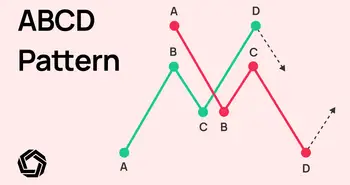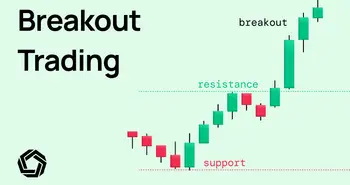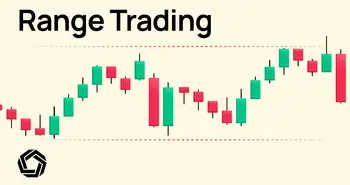Pullback Trading: How to Profit from Market Retracements

What is Pullback Trading
Asset prices never move in a straight line. In a bull market, an asset will make impulsive moves to the upside, followed by brief periods of retracement. The price rallies, and then the price retraces. The latter move is called a pullback.
This type of price action signals a healthy trend, and typically pullbacks have a short duration before the market begins trending upwards again. When the market ranges between support and resistance without breaking out, it's known as a consolidation phase.
Pullback trading leverages these correctional moves, with traders purchasing the retracements of an existing trend. Pullback traders enter trades after identifying an area of value, such as a swing low or support, essentially an area where buying pressure will move into the market to protect specific price points. This trading strategy builds on the age-old trading adage:
‘Buy low, sell high.’
In a bull market, pullback traders buy the dip and sell the move upwards. The core principles underlying pullback trading: the market must be trending, and traders must move with this trend. Pullbacks occur in the market for two primary reasons, buyers take profits, and bearish traders attempt to push the price down.
A Real Life Example
Traders' first priority must be to identify the trend. Without understanding the trend and its direction, pullback traders will get burnt. For example, in 2021, the markets roared upwards, with pullback trading on tech stocks being highly profitable.
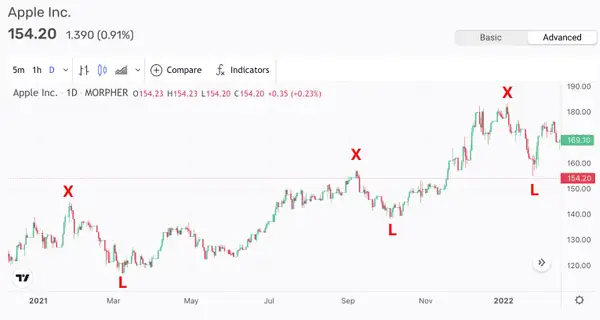
AAPL 1D 2021
X marks the swing highs, and L marks the swing lows. What signals do pullback traders look for? Pullback traders look to enter positions when an asset’s price dips below the prior swing high and look to exit the trade when the price moves closer to the previous swing high.
Depending on how aggressive the trader is, entries and exits will vary. Some traders will wait for the asset to reach a strong support level and retest before buying, and some will enter the trade when the asset price dips below the prior swing high. Specific traders will close positions before the asset reaches its last swing high to lock in profits. Other traders will wait for it to eclipse the prior swing high.
Indicators such as the Relative Strength Index (RSI) can help traders understand when an asset is overbought/ oversold. One of the substantial unseen advantages of pullback trading is that it allows traders to develop better discipline and builds the habit of buying on red days instead of green, a natural counter to FOMO.
Trends in 2022?
Traders who had seen the stock market collapse at the tail end of 2021 and understood increasing concerns surrounding inflation driven by artificial supply shocks and geopolitical instability could have built a short thesis. How do central banks tackle inflation? They raise interest rates. What happens when central banks raise interest rates? The currency strengthens. Who made the most aggressive rate hikes? The FED. This means the dollar should enter an uptrend. The dollar also benefited from a declining appetite for risk assets- the DXY trades inversely to risk assets- and as uncertainty grew, countries with large amounts of debt denominated in USD rushed to buy dollars, further increasing the value. With a thesis like this, traders could have identified that the dollar would enter an uptrend and trade it accordingly.
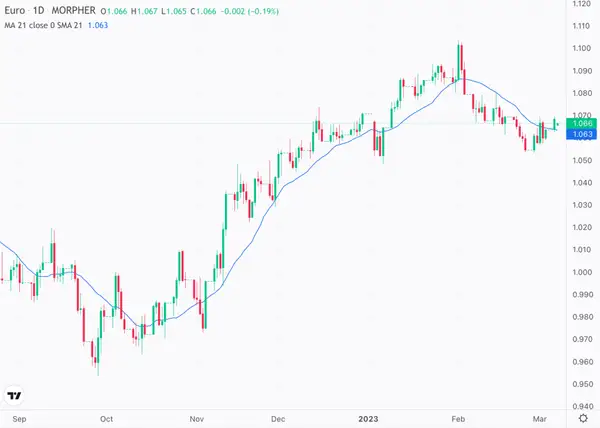
EUR/USD 1D
Pullback traders could have followed a very simplified strategy throughout 2022. As you can see on the graph above, there were at least seven major pullbacks in the EUR/USD. Buying the EUR/USD when it dipped below the 21-day moving average in a correctional wave would end up in a winning streak throughout the whole year.
The Benefits of Pullback Trading
With the confirmed existence of a strong market trend, pullback trading provides a straightforward trading strategy: buy the red, and sell the green. The psychological simplicity of this strategy makes it highly enticing to newer and more experienced traders. Although the above examples feature extended time frames, pullback trading can be applied over smaller time frames just as effectively, if not more effectively.
Pullback trading follows the momentum and sentiment of the market. It requires no intricate contrarian strategy, simply buying the dips in an uptrend and shorting the resistance levels in a downtrend. Pullback trading can be useful regardless of market direction; it only requires a dominant trend.
Pullback trading can be applied to any stock or digital asset and is a highly versatile strategy for traders in all markets. Mastering pullback trading, as mentioned earlier, helps build good foundational habits such as avoiding FOMO and buying on red days instead of green. And mastering solid trading fundamentals and the discipline to buy when others sell makes an average trader a great trader, given sufficient time and application.
The Difference Between a Reversal and a Pullback
‘The trend is your friend.’
The trend is your friend until it isn’t, and traders on the wrong side of what they believe to be a pullback that becomes a reversal can suffer heavy losses- but stop losses mitigate this, hence their importance to traders. A pullback is a momentary change in the price direction. A reversal means a change in the trend. A reversal presents a directional shift that will continue for a prolonged period. One of the difficulties is that a reversal at the start appears as a pullback, and market reversal tends to be hazardous for traders on both sides.
A reversal has several characteristics which help distinguish it from a pullback:
Volume. A large sell volume, such as one driven by institutions, is more characteristic of a reversal, whereas retail selling is more characteristic of a pullback.
Demand. In a trending market, there should be increased buy pressure during a decline; if there is little buy pressure during a decline, this could signal a reversal.
Short Interest. A reversal typically has far higher levels of short interest.
Trendlines. Trendlines are lines drawn on a chart to connect two or more significant price points in key support and resistance areas. If an asset breaks below a key support or resistance level, this signals a reversal.
Candlestick Patterns. Candlestick patterns such as a pin bar, engulfing or morning star are signals for identifying trend reversals.
For example, on September 26 2022, AUD/USD was in a pronounced downtrend. Towards the end of the downtrend, a bullish pin bar pattern formed on the daily chart, indicating a potential shift in market sentiment.
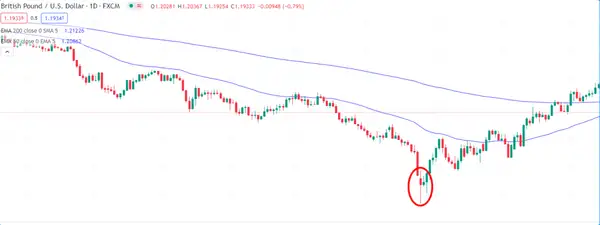
This pin bar had a small body and a long lower wick, suggesting that sellers failed to maintain control and buyers stepped in, pushing the price up. Traders who recognized this pattern as a potential reversal signal may have used it to buy or go long on AUD/USD, expecting the price to continue moving upward. As a result, the pin bar pattern triggered a shift in the trend from a downtrend to an uptrend.
Critical Signs of a Reversal
Macro. One important factor to consider is the macroeconomic environment – has there been a significant shift in the broader economic landscape that could impact the asset you're trading? You should pay attention to changes in the fundamentals of the asset itself. If there are significant changes in the underlying company or industry, this could be a strong indicator of a long-term directional change rather than just a temporary pullback.
Strategies for Pullback Trading
Using Trendlines to Identify Price Reversal Levels
Targeting price reversal levels represents the core building block of pullback traders' market approach. Pullback traders identify areas where prices will likely shift and enter positions as the move begins. Trendlines present an invaluable tool for pullback traders and help smooth out market noise and detect these areas of value. When an asset approaches a trendline, traders should be ready to act.
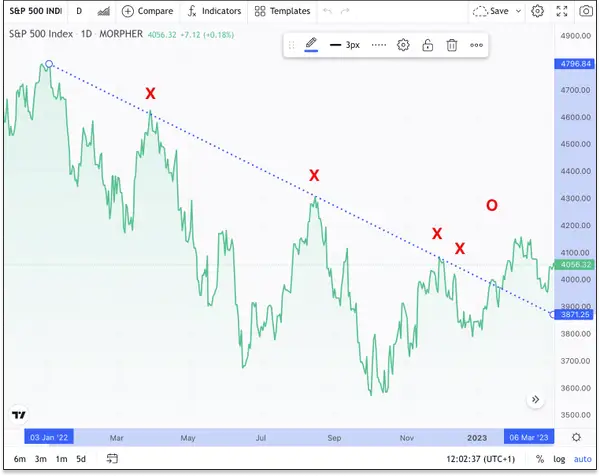
SPX 1D
Above is the S&P 500 Index, which will be used as an example. The market entered a sustained downturn throughout 2022, and a trendline has been drawn. A simple condition for entry could have been when the S&P 500 rallied towards the trendline, accompanied by the RSI signaling it was overbought. When these conditions were met, traders could have shorted the S&P 500 and taken profits at the prior low, or more aggressive traders would perhaps close the position when it made a new low.
Notice the trend was the trader's friend until it wasn’t. Traders who entered short positions according to these conditions in early January hopefully had their positions closed via a stop loss or manually closed their trades when the trendline was broken, retested, and flipped to support. Traders will not win every trade; they give themselves a statistical advantage to become profitable over a long time.
Pullback Depth
The chart below shows Bitcoin in late January with a shorter time frame (one hour).
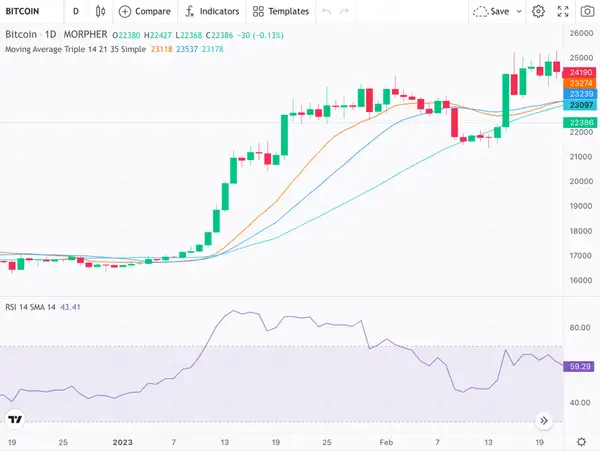
BTC/USDT 1H
At the start of the year, positive momentum had been established. These shallow pullbacks- a correctional move when the price does not visit the previous resistance level before moving upwards again- can be identified with the moving average. When trading shorter time frames, traders should use a shorter moving average, and given their prevalence, traders should use either 21, 50, 100, or 200. Other traders use these levels, and thus they become vital areas.
Bitcoin made shallow retracements, using the 21-day moving average as support, touching, rallying, coming back, and then rallying again. Pullback traders will look to enter when the price touches the moving average (a more aggressive strategy) or enter on the breakout candle that closes above the body of the swing-high candle.
Using Fibonacci Retracements to Profit From Pullbacks
Fibonacci retracements can be used to identify potential reversal levels. Below is the ETH/USDT chart in late 2020.
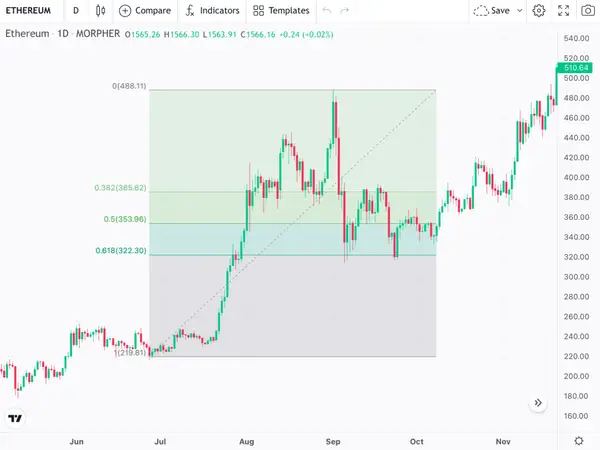
ETH/USDT 1D
Using Fibonacci levels pullback, traders could have identified levels where opening a trade would have been profitable. The key levels to observe that signal potential areas of retracement are 23.6% (a shallow pullback), 38.2%, and 50% (a moderate pullback), and of course, the golden retracement 68% (a deeper pullback).
Although technically not part of the Fibonacci sequence, 50% has become a core zone derived from Dow Theory. In the above example, ETH retraced to the golden ratio, traders stepped in, and ETH rebegan its primary move. Fibonacci retracements should be used in conjunction with other indicators, but given the prevalence of this tool amongst traders, retracements to these levels often become self-fulfilling.
What to Consider in Pullback Trading
When engaging in pullback trading, the trend is everything. Even less experienced investors who identify a strong and solid trend have a chance to outperform more experienced traders trading with a weaker trend. There must be an established trend, and traders must follow it directionally.
After establishing and understanding the trend, traders must focus on areas of value. For example, key support levels in a bullish trend and key resistance levels in a bearish trend. These can be identified through trend lines, moving averages, or Fibonacci retracements. But the trader's mission is to identify levels where buying pressure will step in and begin pushing the price with the trend following the correctional wave.
Entries. Traders must have a specific trigger and reason for entering. The more detailed a trader is, the higher their chance of becoming profitable. Traders must understand what types of trades they take, why they take the trades, and what premises underlie their trades. Over time, usually, traders gravitate towards taking fewer traders with using more size on higher conviction plays.
Indicators. One of the most attractive elements of pullback trading is its reliance on basic indicators. This trading strategy helps traders polish their fundamentals while trading within a trend. The moving average and Fibonacci will be indispensable, but traders should look to improve their ability to draw trendlines and rely on established support and resistance levels. Pullback trading naturally encourages trades to view the market more professionally.
When it comes to making successful pullback trades, the more pronounced the signal, the higher the likelihood of success. Traders must consider other traders and the game theory behind trading. An unmistakable signal, for example, an asset’s price touching the moving average and retesting it again, means they are likely to enter a position. The price resumes the primary trend when many traders globally see the same signal and enter. And for this exact reason, traders should exit their position before a new swing high is formed to guarantee they lock in profits and front-run the crowd. A trade does not mean anything until it is closed.
Conclusion
Pullback trading takes advantage of the market’s erratic moves in a trend to buy assets at a discount before the trend continues. It centers on following momentum and sentiment and requires no intricate contrarian strategy; it follows the basic principles of buying red and selling green.
Traders identify value areas and move with the market, and pullback trading is an excellent option for both short and long-term trades. Traders can take advantage of hourly drawbacks. Or take week/month-long trades and fully capitalize on significant market swings. Understanding pullback trading engrains fundamentals into traders, making them more proficient in other strategies and bolstering their broader macro understanding of how asset prices move.
The psychological simplicity of this strategy and its anchorage in simple indicators make it a great play for beginners and highly profitable for experienced traders to grow their trading accounts. It is open for interpretation, and traders can choose their own suite of indicators to identify value areas. Traders can backtest these theses and then take them to market.

Disclaimer: All investments involve risk, and the past performance of a security, industry, sector, market, financial product, trading strategy, or individual’s trading does not guarantee future results or returns. Investors are fully responsible for any investment decisions they make. Such decisions should be based solely on an evaluation of their financial circumstances, investment objectives, risk tolerance, and liquidity needs. This post does not constitute investment advice.

Painless trading for everyone
Hundreds of markets all in one place - Apple, Bitcoin, Gold, Watches, NFTs, Sneakers and so much more.

Painless trading for everyone
Hundreds of markets all in one place - Apple, Bitcoin, Gold, Watches, NFTs, Sneakers and so much more.

